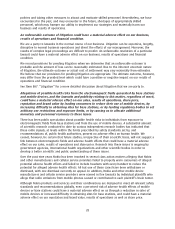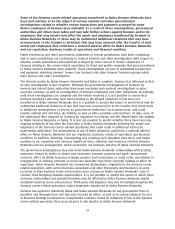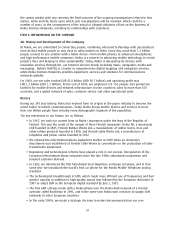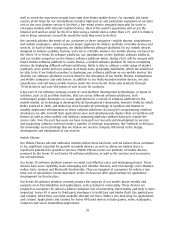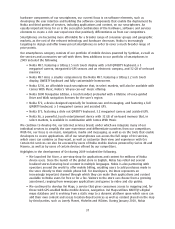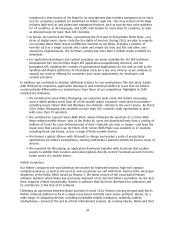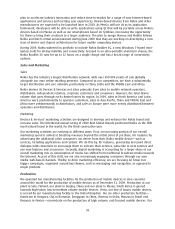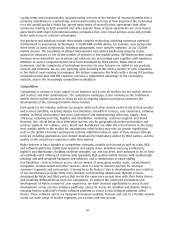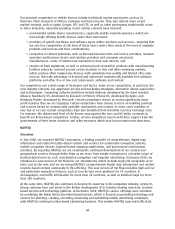Nokia 2009 Annual Report Download - page 39
Download and view the complete annual report
Please find page 39 of the 2009 Nokia annual report below. You can navigate through the pages in the report by either clicking on the pages listed below, or by using the keyword search tool below to find specific information within the annual report.hardware components of our smartphones, our current focus is on software elements, such as
developing the user interface and building the software components that enable the deployment by
Nokia and third parties of services, including applications and content, on our smartphones. An
equally important focus for us is the successful combination of the hardware, software and services
elements to create a rich user experience that positively differentiates us from our competitors.
Smartphones are becoming more affordable for a broader range of consumer groups and geographic
markets, as the cost of the relevant technology and hardware decreases. Nokia is increasingly
targeting to design and offer lowerpriced smartphones in order to cover a much broader range of
price points.
Our smartphones category consists of our portfolio of mobile devices powered by Symbian, as well as
the services and accessories we sell with them. New additions to our portfolio of smartphones in
2009 included the following.
• Nokia N97, featuring a tilting 3.5 inch touch display with a full QWERTY keyboard, a 5
megapixel camera, integrated AGPS sensors and an electronic compass, and 32 GB of onboard
memory.
• Nokia N97 mini, a smaller companion to the Nokia N97, featuring a tilting 3.2 inch touch
display, QWERTY keyboard and fully customizable homescreen.
• Nokia 5230, an affordable touch smartphone that, in select markets, will also be available with
Comes With Music, Nokia’s ’allyoucaneat’ music offering.
• Nokia 5800 Navigation Edition, a touch handset preloaded with a lifetime of voiceguided
Drive and Walk navigation licenses for the user’s region.
• Nokia E72, a device designed especially for business use and messaging, and featuring a full
QWERTY keyboard, a 5 megapixel camera and assisted GPS.
• Nokia E75, featuring a slide out QWERTY keyboard, 3.2 megapixel camera and assisted GPS.
• Nokia X6, a powerful, touch entertainment device with 32 GB of onboard memory that, in
select markets, is available in combination with Comes With Music.
We continue to develop Ovi, our Internet services brand, under which we integrate many of our
individual services to simplify the user experience and differentiate ourselves from our competitors.
With Ovi, our focus is on music, navigation, media and messaging, as well as on the tools that enable
developers to create applications. All of our smartphones can access the full range of Ovi services,
which users can combine as they want, as well as customize their view and experience with Ovi.
Certain Ovi services can also be accessed by users of Nokia mobile devices powered by Series 40 and
Maemo, as well as by users of certain devices offered by our competitors.
Highlights in the development of Ovi during 2009 included the following.
• We launched Ovi Store, a onestop shop for applications and content for millions of Nokia
device users. Since the launch of the global store in English, Nokia has rolled out several
localized stores featuring local content in multiple languages. Nokia is also partnering with
operators around the world to offer mobile billing, enabling users to add purchases made in
the store directly to their mobile phone bill. For developers, Ovi Store represents an
increasingly important channel through which they can make their applications and content
available to Nokia users for free or for a fee. Visitors to the store can choose from a growing
assortment, ranging from newspaper applications and games to video and city guides.
• We continued to develop Ovi Maps, a service that gives consumers access to mapping and, for
those with GPSenabled Nokia mobile devices, navigation. Ovi Maps utilizes NAVTEQ’s digital
maps database and is evolving from a static map to a dynamic platform upon which users can
add their own content and access locationbased services as well as content placed on the map
by third parties, such as Lonely Planet, Michelin and WCities. During January 2010, Nokia
37



